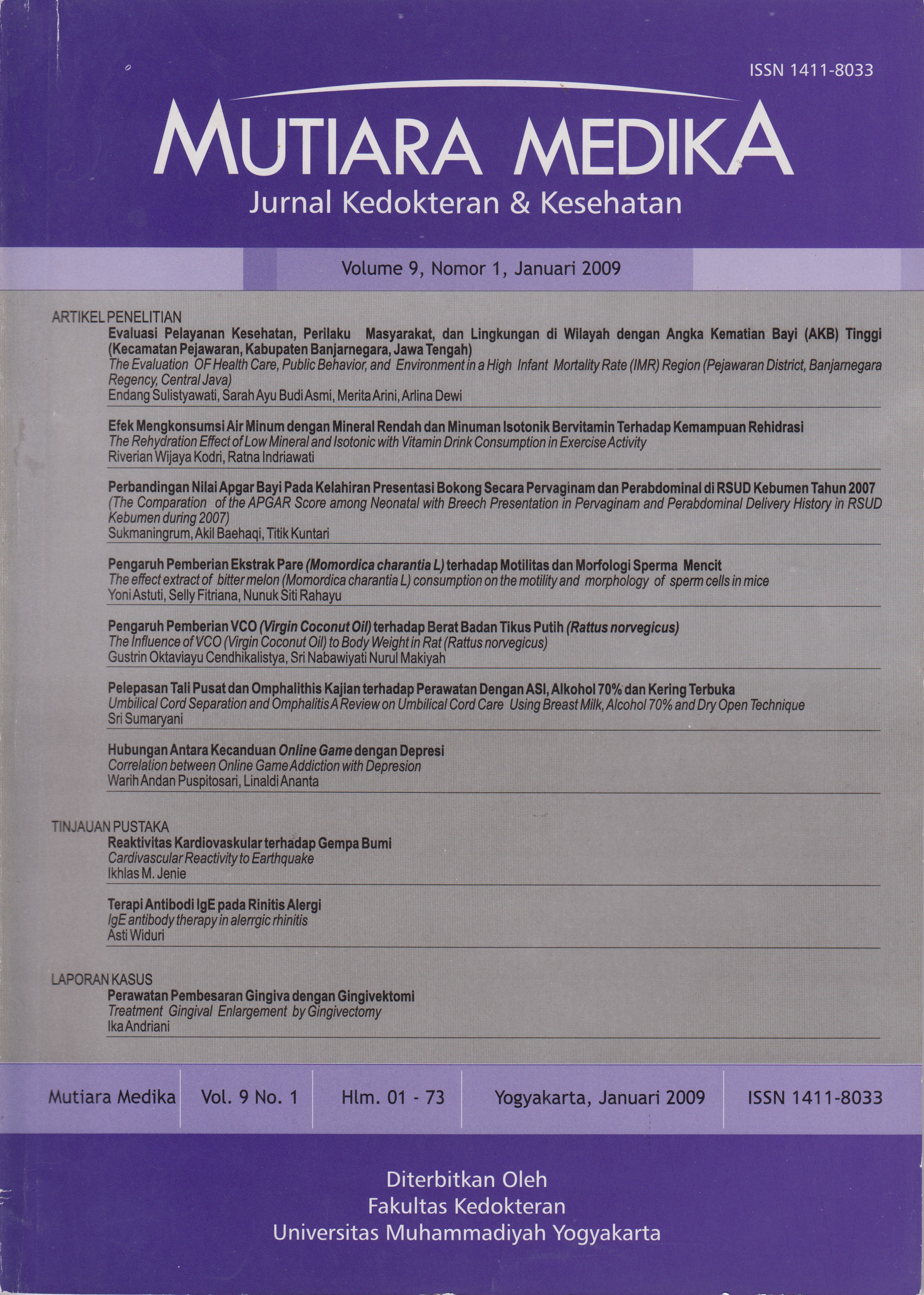Terapi Antibodi IgE pada Rinitis Alergi
DOI:
https://doi.org/10.18196/mmjkk.v9i1.1594Keywords:
antibodi IgE, rinitis alergi, terapi, allergic rhinitis, antibody IgE, therapyAbstract
Allergic rhinitis is a highly prevalent respiratory disease, affecting up to 40% of the population in some countries, and has an important impact on quality of life. Although a number of different drug types are available for treating allergic rhinitis, antihistamines are currently considered first line therapy. Most current treatments only relieve symptoms and do not modify the course of the disease. IgE may play a role in allergic sensitization, interaction between allergens and IgE leads to activation of mast cell, with consequent release of histamine andother pro-allergic mediators. IgE therefore potentially represents an important target for pharmacological intervention in allergic rhinitis.
Rinitis alergi adalah penyakit saluran pernafasan yang tinggi prevalensinya, mengenai sampai 40% populasi di beberapa negara, dan menimbulkan dampak yang serius pada kualitas hidup. Meskipun bermacam-macam obat dapat digunakan untuk mengobati rinitis alergi, antihistamin yang merupakan pilihan obat pertama. Hampir seluruh pengobatan rinitis alergi hanya ditujukan untuk mengurangi gejala tetapi tidak merubah perjalanan penyakitnya. IgE kemungkinan berperan pada proses sensitisasi, interaksi antara alergen-alergen dengan IgE akan mengaktivasi sel mast yang akan mengeluarkan histamin dan mediator-mediator alergi yang lain. Sehingga IgE memiliki potensi sebagai target intervensi pengobatan secara farmakologis yang penting dalam penanganan rinitis alergi.
References
Bousquet J., Cauwenberge V.P.and Khaltev P. Allergic rhinitis and its impact on asthma. J. Allergy Clin Immunol 2001 ; 108 : S148-S195.
Sudarman K dan Soekardono S. Penatalaksanaan rinitis alergika. Simposium Penatalaksanaan
Penyakit-penyakit Alergi Secara Rasional Yogyakarta 1996.
Sudarman K. Pengelolaan penyakit rinitis alergi. Simposium pengelolaan penyakit alergi secara rasional, Yogyakarta 2001: 49-65.
Baratawidjaja K., Molekul adhesi pada inflamasi tantangan baru untuk para klinikus. Majalah Kedokteran Indonesia 1996; 46 : 223-228.
Suprihati, Madiadipura T, Sumarman I. Penatalaksanaan rinitis alergi sesuai WHO-ARIA. Dalam Konas PerhatiXIII Bali 2003: 1-14.
Van Cauwen Berge P, De-Belder T, Vermeiren J, Kaplan A. Global Resources in Allergy (GLORIA) : allergic rhinitis and allergic cunjunctivitis. Clin Exp All Rev 2003;3:46-50.
Naclerio R, Rosenwasser L, Ohkubo K. Allergic rhinitis : current and future treatments. Clin Exp All Rev 2002;2:137-147
Holgate ST. Today’s science-tomorrow’s practice: basic mechanisms of allergy and their clinical implication. Clin Exp All Rev 2002;2: 48-54.
Babu KS, Arshad SH, Holgate ST. Anti- IgE treatment: an up date. J All 2001;56:1121-1128.
Pescovitz MD. Rituximab, an Anti CD20 monoclonal antibody : History and Mechanism of Action. Am J of Transp 2005.
Rigbi LJ, Trist H, Sunder J, Hulet MD, Hogarth PM. Monoclonal antibody and synthetic peptides define the active site of FcaRI and a potential receptor antagonist. Allergy 2000;55:609-619.
Holgate ST, Djukanovic R, Casalet T, Bousqet J. Anti-immunoglobulin E treatment with omalizumab in allergic disease: an update on anti-inflammatory activity and clinical efficacy. Clin Exp All 2005;35:408-416.
Hamelmann E, Rolinc-Wernighans C, Wahn U. From IgE to Anti-IgE: where do we stand? Allergy 2002;57: 983-994.
Fahy JV, Boushey HA. Targetting IgE with monoclonal antibodies : the future is now. Clin Exp All Rev 1998;28: 664¬667.
Arshad SH, Holgate S. The role of IgE in allergen-induced inflammation and the potential for intervention with a humanized monoclonal anti IgE antibody. Clin Exp All 2001;31:1344- 1351
Downloads
Published
Issue
Section
License
Copyright
Authors retain copyright and grant Mutiara Medika: Jurnal Kedokteran dan Kesehatan (MMJKK) the right of first publication with the work simultaneously licensed under an Attribution 4.0 International (CC BY 4.0) that allows others to remix, adapt and build upon the work with an acknowledgment of the work's authorship and of the initial publication in Mutiara Medika: Jurnal Kedokteran dan Kesehatan (MMJKK).
Authors are permitted to copy and redistribute the journal's published version of the work (e.g., post it to an institutional repository or publish it in a book), with an acknowledgment of its initial publication in Mutiara Medika: Jurnal Kedokteran dan Kesehatan (MMJKK).
License
Articles published in the Mutiara Medika: Jurnal Kedokteran dan Kesehatan (MMJKK) are licensed under an Attribution 4.0 International (CC BY 4.0) license. You are free to:
- Share — copy and redistribute the material in any medium or format.
- Adapt — remix, transform, and build upon the material for any purpose, even commercially.
This license is acceptable for Free Cultural Works. The licensor cannot revoke these freedoms as long as you follow the license terms. Under the following terms:
Attribution — You must give appropriate credit, provide a link to the license, and indicate if changes were made. You may do so in any reasonable manner, but not in any way that suggests the licensor endorses you or your use.
- No additional restrictions — You may not apply legal terms or technological measures that legally restrict others from doing anything the license permits.






